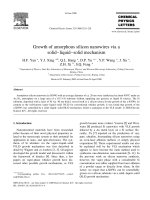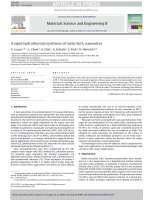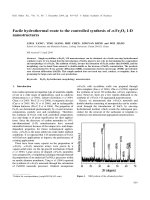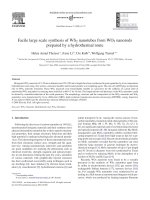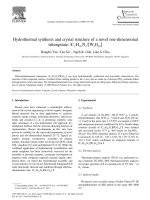- Trang chủ >>
- Khoa Học Tự Nhiên >>
- Vật lý
a rapid hydrothermal synthesis of rutile sno2 nanowires
Bạn đang xem bản rút gọn của tài liệu. Xem và tải ngay bản đầy đủ của tài liệu tại đây (520.26 KB, 4 trang )
Please cite this article in press as: O. Lupan, et al., Mater. Sci. Eng. B (2009), doi:10.1016/j.mseb.2008.12.035
ARTICLE IN PRESS
G Model
MSB-11957; No.of Pages4
Materials Science and Engineering B xxx (2009) xxx–xxx
Contents lists available at ScienceDirect
Materials Science and Engineering B
journal homepage: www.elsevier.com/locate/mseb
A rapid hydrothermal synthesis of rutile SnO
2
nanowires
O. Lupan
a,b,∗
, L. Chow
a
, G. Chai
c
, A. Schulte
a
,S.Park
a
, H. Heinrich
a,d
a
Department of Physics, University of Central Florida, PO Box 162385, Orlando, FL 32816-2385, USA
b
Department of Microelectronics and Semiconductor Devices, Technical University of Moldova, Stefan cel Mare Blvd. 168,
Chisinau MD-2004, Republic of Moldova
c
Apollo Technologies, Inc. 205 Waymont Court, S111, Lake Mary, FL 32746, USA
d
Advanced Materials Processing and Analysis Center, and Department of Mechanical, Materials, and Aerospace Engineering,
University of Central Florida, Orlando, FL 32816, USA
article info
Article history:
Received 20 June 2008
Received in revised form 11 November 2008
Accepted 22 December 2008
Keywords:
Tin oxide
Nanowires
Nanoneedles
Hydrothermal synthesis
abstract
Tin oxide (SnO
2
) nanowires with rutile structure have been synthesized by a facile hydrothermal method
at 98
◦
C. The morphologies and structural properties of the as-grown nanowires/nanoneedles were char-
acterized by scanning electron microscopy (SEM), transmission electron microscopy (TEM), selected
area electron diffraction, X-ray diffraction and Raman spectroscopy. The SEM images reveal tetragonal
nanowires of about 10–100 m in length and 50–100 nm in radius. The Raman scattering peaks indicate
a typical rutile phase of the SnO
2
. The effects of molar ratio of SnCl
4
to NH
4
OH on the growth mechanism
are discussed.
© 2009 Elsevier B.V. All rights reserved.
1. Introduction
A new generation of one-dimensional (1D) nanoarchitectures,
such as nanowires, nanorods and nanoneedles has been produced
and attracted considerable attention in the materials research com-
munity [1]. The interest is motivated by the physical and chemical
properties, which are highly dependent on the aspect ratio and
shape [1,2]. Extensive ef forts have been made on developing new
methods to synthesize, manipulate and tailoring functionalities of
a variety of 1D nanostructured materials (SnO
2
, ZnO, CdS, In
2
O
3
,
etc.) [1–3]. Among them, rutile SnO
2
, an n-type semiconductor with
a wide band gap (Eg = 3.62 eV at 300 K), and excellent optical and
electrical properties, is a strategic material for a range of techno-
logical applications [4]. Its practical uses include ultrasensitive gas
sensors [5], optoelectronic devices [6], electrodes for solar cells [4]
and anode material for lithium batteries [7].
SnO
2
nanoarchitectures have been synthesized by the self-
catalytic vapor–liquid–solid (VLS) method [6], calcination process
[7], chemical vapor deposition [8], thermal evaporation [1],
hydrothermal [9], laser ablation technique [10], solvothermal [11]
and carbothermal reduction [12]. These techniques all require a
growth temperature of 900
◦
C or higher, which makes them dif-
ficult for certain device applications and which are often difficult
∗
Corresponding author at: Department of Physics, University of Central Florida,
PO Box 162385, Orlando, FL 32816-2385, USA. Tel.: +1 407 823 2333;
fax: +1 407 823 5112.
E-mail addresses: , (O. Lupan).
to control reproducibly [13]. Guo et al. [14] has reported a low-
temperature hydrothermal synthesis of SnO
2
nanorods at 160
◦
C,
but the process requires at least 12h. Vayssieres and Graetzel [15]
reported SnO
2
nanorods arrays grown on F-SnO
2
glass substrates
by aqueous thermohydrolysis at 95
◦
C.
This paper presents an inexpensive and rapid fabrication tech-
nique for one-dimensional (1D) tin oxide (SnO
2
) nanowires with
rutile structure synthesized by a facile hydrothermal method at
95–98
◦
C for 15 min. It permits rapid and controlled growth of
tin oxide nanowires without the use of templates or seeds. The
obtained tin oxide nanowires are distributed on the surface of
Si/SiO
2
substrates and individual nanowires can be easily trans-
ferred to other substrates which are decisive factor for single
nanowire ultrasensitive sensors fabrication.
Our technique is faster and cost-effective, which is important for
large scale applications in nanoelectronics/nanotechnologies and
can find a wide range of applications.
2. Experimental
Rutile-structured SnO
2
nanowires/nanoneedles were synthe-
sized at a low temperature by a hydrothermal method without
any other seeds, templates or surfactant. A solution containing tin
chloride [SnCl
4
·5H
2
O, 0.01–0.03 M] (purity 99.5%) and ammonia
[NH
4
(OH), 29.5%] (Fisher Scientific) was employed for growth of tin
oxide nanowires and nanoneedles. Both reagents were used in the
received form without further purification. A hydrothermal reactor
[3] with a cap was filled with aqueous solution. In a typical pro-
cedure, Si wafers and glass substrates were cleaned according to
0921-5107/$ – see front matter © 2009 Elsevier B.V. All rights reserved.
doi:10.1016/j.mseb.2008.12.035
Please cite this article in press as: O. Lupan, et al., Mater. Sci. Eng. B (2009), doi:10.1016/j.mseb.2008.12.035
ARTICLE IN PRESS
G Model
MSB-11957; No.of Pages4
2 O. Lupan et al. / Materials Science and Engineering B xxx (2009) xxx–xxx
Fig. 1. XRD pattern of the SnO
2
nanowires prepared through the hydrothermal
reaction on a SiO
2
/Si substrate.
previous work [16]. Subsequently, a piece of cleaned Si substrate
was placed in the reactor and healed at a temperature 95–98
◦
Cfor
15min on a hot plate [3]. Then the reactor was allowedto cool down.
Finally, the SnO
2
nanowires were thoroughly washed with deion-
ized water to eliminate residual unreacted species and the reaction
byproduct, and annealed at 370
◦
C for 5 min.
A scanning electron microscope (SEM, JEOL 6400F) was used to
observe the SnO
2
nanowires using an operating voltage of 10 kV.
The obtained samples were characterized by X-ray powder diffrac-
tion (XRD) using a Rigaku ‘D/B max’ X-ray diffractometer with Cu
K␣ radiation ( = 1.54178 Å) operating at 40 kV and 30 mA. Trans-
mission electron microscopy (TEM) of the samples was performed
with a FEI Tecnai F30 transmission electron microscope operated
at an accelerating voltage of 300 kV. For the TEM observation, the
samples were collected on a carbon holey grid. The composition
was characterized by Energy Dispersion X-ray Spectroscopy (EDX)
in SEM and TEM. Micro-Raman measurements wereperformed on a
Horiba Jobin Yvon LabRam IR system at a spatial resolution of 2 m.
Raman scattering was excited with the 633 nm line of a He–Ne laser
with output power less than 4 mW at the sample.
3. Results and discussion
Fig. 1 shows the XRD patterns from the synthesized SnO
2
sam-
ples which demonstrates the SnO
2
tetragonal rutile structure with
lattice constants a = b = 0.4743 nm and c = 0.3186 nm, which match
well with the standard XRD data file of SnO
2
(JCPDS-041-1445)
(ICSD data) [17]. The peaks were sharp indicating high crystallinity
of SnO
2
nanowires.
Fig. 2(a) and (b) shows the detailed morphologies of the
SnO
2
nanowires prepared through the hydrothermal reaction. The
nanowires/nanoneedles have a uniform length of about 10–20m
and diameters of about 0.1 m(Fig. 2a) grown by using precursor
with the ratio between SnCl
4
and NH
4
OH as (1:25).
The morphology of nanowires was found to be dependent on the
synthesis conditions. The dimensions and aspect ratio are a func-
tion of growth time, temperature and Sn
4+
/OH
−
ratio in solution.
Thus, by this method, we also synthesized SnO
2
thinner nanowires
(Fig. 2a) by decreasing the concentration of SnCl
4
in solution. Fig. 2b
shows the morphology of SnO
2
nanowires synthesized at 95
◦
Con
a SiO
2
/Si substrate synthesized according to technology reported
previously [3]. The nanowires with larger radius were synthesized
by using precursor with the ratio between SnCl
4
and NH
4
OH of
(1:20) (Fig. 2b). In the inset of Fig. 2b the end planes of the SnO
2
nanowires clearly reflect the tetragonal symmetry. The products
consisted of nanowires as well as nanoparticles. The diameters of
tin oxide nanowires are in the range of 70–150 nm with lengths of
the order of 20–100 m.
When the ratio between SnCl
4
and NH
4
OH is as high as 1:20 we
obtain long tetragonal square-based nanowires. Experiment results
showed that the molar ratio of (1:20) made the hydrolysis occur
rapidly due to of higher quantity of nuclei. By further increasing
the ratio above 1:30 no products is formed and we have only solu-
tion. This can be explained by the fact that the quantity of nuclei
depends on the precursor concentration and by increasing OH
−
ion
concentration means the decreasing Sn
4+
ion concentration (the
totalvolume of solution is fixed). Therefore,SnO
2
nanowires growth
dependent on the degree of supersaturation and Sn
4+
, served as the
precursor in reverse micelle. Thus at higher OH
−
ion concentration
growth of nanowires do not take place.
The transmission electron microscopy (TEM) image in Fig. 3
shows the tin oxide nanowires/nanoneedles which were synthe-
sized. The TEM images indicate that the entire as-grown nanowires
are single-crystalline SnO
2
with a rutile structure grown along the
[1 0 1] direction, which is consistent with the XRD results. The
HRTEM lattice fringes and SAED patterns shown in Fig. 3 reveal that,
in this region, the nanowires possess a single-crystalline structure.
Typical selected-area electron diffraction (SAED) pattern (Fig. 3),
indicates that the nanowires are good quality with rutile SnO
2
structure. According to the SAED pattern taken, the growth direc-
tion of tin oxide nanowires is along [1 0 1] direction. This is in
agreement with previous reports [18].
Fig. 2. Scanning electron micrographs of hydrothermally grown (a) SnO
2
nanowires on a SiO
2
/Si substrate; (b) SnO
2
nanowires/nanoneedles on a SiO
2
/Si substrate. The inset
is a magnified image of the end planes of the tetragonal SnO
2
nanowires.
Please cite this article in press as: O. Lupan, et al., Mater. Sci. Eng. B (2009), doi:10.1016/j.mseb.2008.12.035
ARTICLE IN PRESS
G Model
MSB-11957; No.of Pages4
O. Lupan et al. / Materials Science and Engineering B xxx (2009) xxx–xxx 3
Fig. 3. HRTEM images of an individual SnO
2
nanowire. The upper right inset is a
SAED of a single-crystalline SnO
2
nanowire.
In order to study the local structure of tin oxide samples
we employed Raman spectroscopy at room temperature to study
effects of crystal structure, defects and structural disorder in SnO
2
nanowires/nanoneedles.
The rutile structure SnO
2
belongs to the point group D
14
4h
and
space group p
4
/mnm [21–23] with tin and oxygen atoms in a 2a
and 4f positions, respectively. On the basis of group theory [23] the
normal lattice vibration at the point of the Brillouin zone is as
follows [24]:
=
+
1
(1A
1g
) +
+
2
(1A
2g
) +
+
3
(1B
1g
) +
+
4
(1B
2g
) +
−
5
(1E
g
)
+
−
1
(1A
2u
) + 2
−
4
(B
1u
) + 3
+
5
(E
u
) (1)
The Raman active modes are B
1g
, E
g
, A
1g
, and B
2g
. In these modes
the oxygen atoms vibrate while the Sn atoms are at rest. The E
g
,
mode represents vibrations with displacements in the direction of
the c-axis, but A
1g
, and B
1g
, are vibrations with displacements in
directions perpendicular to the c-axis [25]. Seven modes of A
2u
,
and 3E
u
, are infrared (IR) active and two modes of A
2g
, and B
1u
,are
inactive [23].
Fig. 4 shows the Raman spectra of the nanowires in the
wavenumber range (300–850 cm
−1
). Raman spectra of SnO
2
films
and single crystals have been extensively studied and reported
Fig. 4. Micro-Raman scattering spectra of the rutile tin oxide nanowires.
[19–26]. However,for nanowires the surfaceatoms representa non-
negligible fraction of atoms [24] and may cause specific spectral
changes. In our samples there are Raman peaks at 354, 390, 475,
497, 635, 690, and 777cm
−1
in the Raman spectra (Fig. 4), which are
in agreement with those of a rutile SnO
2
single crystal [19–25]. This
is in agreement with the results of group-theory analysis [20,21].
These peaks are attributed to the (E
u
)V
2(LO)
, A
2g
, E
g
,(A
2u
)V
(TO)
, A
1g
,
(A
2u
)V
(LO)
, and B
2g
, vibrational modes of SnO
2
[22–25].
The A
1g
mode at 635 cm
−1
in Fig. 4 showed line broadening due
to finite size of the diameter (∼100 nm) of nanoneedle (nanowire),
which is in accordance with previous report [26].
In Fig. 4 the dominant peak (635 cm
−1
) is assigned to the A
1g
,
vibrational mode of the SnO
2
crystal. This band is sensitive to the
size [21]. A red shift for A
1g
, was observed in our experiments with
decrease of SnO
2
nanocrystal size. From the morphological investi-
gation and the structural characterization of nanowires, we propose
the following growth mechanism.
The molar ratio of Sn
4+
to OH
−
was found to be an important
parameter that influences the tin oxide nanomaterial morphology.
At lower ratios we obtained only irregular nano/microparticles. We
observed that the aspect ratio of as-prepared SnO
2
nanowires as
the molar ratio of SnCl
4
to NH
4
OH varies from 1:10 to 1:30 (Fig. 2a
and b), which is in agreement with previous reports [27,28].
The growth of SnO
2
nanowires occurs according to the following
reaction [27,28]:
NH
4
OH ↔ NH
3
+ H
2
O (2)
2H
2
O ⇔ H
3
O
+
+ OH
−
,K
w
= 10
−14
ion-productconstant (3)
At the beginning a higher Sn
4+
, ion concentration accelerates the
nucleation process [28] and nuclei are formed:
Sn
4+
+ 4OH
−
→ SnO
2
+ 2H
2
(4)
Sn
4+
+ 4OH
−
→ Sn(OH)
4
(5)
Sn
4+
+ 6OH
−
→ (Sn(OH)
6
)
2−
(6)
The amphoteric hydroxide Sn(OH)
4
dissolves in ammonia solution
and forms Sn(OH)
2−
6
anions.
Sn(OH)
4
hydrothermal condition
−→ SnO
2
+ 2H
2
O (7)
(Sn(OH)
6
)
2−
hydrothermal condition
−→ SnO
2
+ 2H
2
O + 2OH
−
(8)
The concentration of tin ions in solution is of influencing to the
diameter of nanowires. We found that the molar ratio of Sn
4+
,to
OH
−
, ions for the optimal growth of elongated SnO
2
nanowires is
1:20–25.
4. Conclusion
In summary, a rapid hydrothermal method was developed to
synthesize long SnO
2
nanowires at low temperature for 15–20 min.
We investigated the synthesis of SnO
2
nanowires/nanoneedles
by a low-temperature (95–98
◦
C) hydrothermal method. The as-
grown SnO
2
nanowires have diameters of 50–150 nm and lengths
of 10–100 m. The individual straight nanowires have a rectangular
cross-section.
The Raman spectra and XRD pattern demonstrate that the
nanowires are single-crystalline tin oxide with rutile structure. The
shift of Raman peaks to a lower frequency can be associated with
the size effect in nanowires.
The growth mechanism of SnO
2
nanowires is also discussed.
The technique reported here could open new applications of SnO
2
nanowires, especially for ultrasensitive gas nanosensors [29] and
nanodevices fabrication [30,31,32]. Further work on optimization
of the synthesis conditions such as heating rate and duration to
control the aspect ratio of the nanowires is underway.
Please cite this article in press as: O. Lupan, et al., Mater. Sci. Eng. B (2009), doi:10.1016/j.mseb.2008.12.035
ARTICLE IN PRESS
G Model
MSB-11957; No.of Pages4
4 O. Lupan et al. / Materials Science and Engineering B xxx (2009) xxx–xxx
Acknowledgements
Dr. L. Chow acknowledges financial support from Apollo Tech-
nologies, Inc. and the Florida High Tech Corridor Research Program.
Raman measurements were supported in part by NSF MRI grant
DMR-0421253. The research described here was made possible in
part by an award 036/RF and an award for young researchers (O.L.)
(MTFP-1014B Follow-on) from the Moldovan Research and Devel-
opment Association (MRDA) under funding from the U.S. Civilian
Research & Development Foundation (CRDF).
References
[1] Z.W. Pan, Z.R. Dai, Z.L. Wang, Science 291 (2001) 1947.
[2] A.P. Alivisatos, Science 271 (1996) 933.
[3] O. Lupan, L. Chow, G. Chai, B. Roldan, A. Naitabdi, A. Schulte, Mater. Sci. Eng. B
145 (2007) 57.
[4] B. Liu, H.C. Zeng, J. Phys. Chem. B 108 (2004) 5867.
[5] G. Sberveglieri, C. Baratto, E. Comini, G. Faglia, M. Ferroni, A. Ponzoni, A. Vom-
iero, Sens. Actuators B 121 (2007) 208.
[6] Y.Q. Chen, X.F. Cui, K. Zhang, D.Y. Pan, S.Y. Zhang, B. Wang, J.G. Hou, Chem. Phys.
Lett. 369 (2003) 16.
[7] M.Li, Q. Lu, Y.Nuli, X. Qian, Electrochem. Solid-State Lett. 10 (8) (2007) K33–K37.
[8] D. Calestani, M. Zha, A. Zappettini, L. Lazzarini, G. Salviati, L. Zanotti, G. Sberveg-
lieri, Mater. Sci. Eng. C 25 (2005) 625.
[9] O. Lupan, L. Chow, G. Chai, H. Heinrich, S. Park, A. Schulte, J. Cryst. Growth 311
(2008) 152.
[10] Z.Q. Liu, D.H. Zhang, S. Han, C. Li, T. Tang, W. Jin, X.L. Liu, B. Lei, C.W. Zhou, Adv.
Mater. 15 (2003) 1754.
[11] G. Cheng, K. Wu, P. Zhao, Y. Cheng, X. He, K. Huang, J. Cryst. Growth 309 (2007)
53.
[12] J.X. Wang, D.F. Liu, X.Q. Yan, H.J. Yuan, L.J. Ci, Z.P. Zhou, Y. Gao, L. Song, L.F. Liu,
W.Y. Zhou, G. Wang, S.S. Xie, Solid State Commun. 130 (2004) 89.
[13] S. Budak, G.X. Miao, M. Ozdemir, K.B. Chetry, A. Gupta, J. Cryst. Growth 291
(2006) 405.
[14] C. Guo, M. Cao, C. Hu, Inorg. Chem. Commun. 7 (2004) 929.
[15] L. Vayssieres, M. Graetzel, Angew. Chem. Int. Ed. 43 (28) (2004) 3666.
[16] O.I. Lupan, S.T. Shishiyanu, L. Chow, T.S. Shishiyanu, Thin Solid Films 516 (2008)
3338.
[17] Joint Committee on Powder Diffraction Standards, Powder Diffraction File No.
JCPDS-41-1445) (ICSD data).
[18] Z.R. Dai, Z.W. Pan, Z.L. Wang, Adv. Funct. Mater. 13 (2003) 9.
[19] J.F. Scott, J. Chem. Phys. 53 (1970) 852.
[20] H. Kohno, T. Iwasaki, Y. Mita, S. Takeda, J. Appl. Phys. 91 (2002) 3232.
[21] V.G. Kravets, Opt. Spectrosc. 103 (2007) 766.
[22] P.S. Peercy, B. Morosin, Phys. Rev.B7(1973)2779.
[23] J.G. Traylor, H.G. Smith, R.M. Nicklow, M.K. Wilkinson, Phys. Rev. B 3 (1971)3457.
[24] Z.W. Chen, J.K.L. Lai, C.H. Shek, Phys. Rev. B 70 (2004) 165314.
[25] R.S. Katiyars, P. Dawsons, M.M. Hargreaves, G.R. Wilkinson, J. Phys. C: Solid State
Phys.4(1971)2421.
[26] A. Dieguez, A. Romano-Rodriguez, A. Vila, J.R. Morante, J. Appl. Phys. 90 (2001)
1550.
[27] J. Zhang, L.D. Sun, J.L. Yin, H.L. Su, C.S. Liao, C.H. Yan, Chem. Mater. 14 (2002)
4172.
[28] D.F. Zhang, L.D. Sun, J.L. Yin, C.H. Yan, Adv. Mater. 15 (2003) 1022.
[29] F. Hernández-Ramírez, A. Tarancón, O. Casals, J. Arbiol, A . Romano-Rodríguez,
J.R. Morante, Sens. Actuators B 121 (2007) 3.
[30] O. Lupan, G. Chai, L. Chow, Microelectr. J. 38 (12) (2007) 1211.
[31] O. Lupan, G. Chai, L. Chow, Microelectr. Eng. 85 (11) (2008) 2220.
[32] O. Lupan, L. Chow, G. Chai, L. Chernyaka, O. Lopatiuk-Tirpaka, H. Heinrich, Phys-
ica Status Solidi (a) 205 (2008) 2673.




